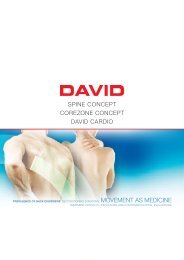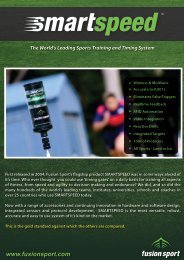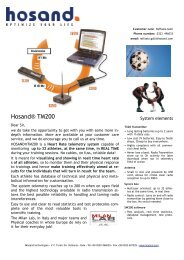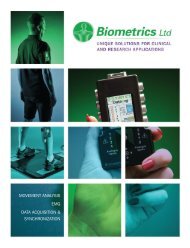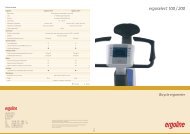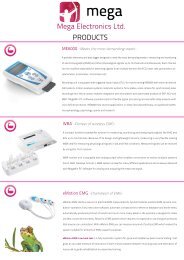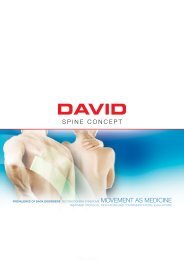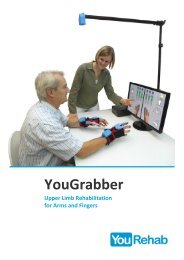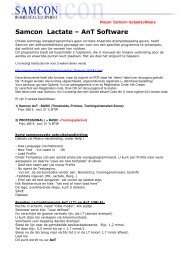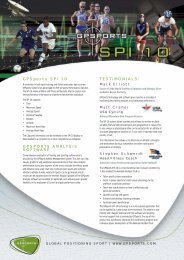E-LINK - Samcon
E-LINK - Samcon
E-LINK - Samcon
- No tags were found...
You also want an ePaper? Increase the reach of your titles
YUMPU automatically turns print PDFs into web optimized ePapers that Google loves.
EVALUATION & EXERCISE OVERVIEWH500 HAND KIT0708EVALUATION & EXERCISE BIOMETRICES / E-<strong>LINK</strong>E-<strong>LINK</strong> modules for Evaluation and Exercisecombine precision instruments for clinicalmeasurements with computerized activitiesto provide unique opportunities for bothphysical and neurological rehabilitation.The H500 Hand Kit consisting of theDynamometer for hand grip strengthmeasurement and the Pinchmeter for hand pinchstrength measurements.◗The Biometrics Dynamometer utilises precision load celltechnology to increase the sensitivity and accuracy ofmeasurement of even very low grip strength forces. By usingthe industry standard Jamar design exterior, comparisons canbe made with standardized normative data included in theE-<strong>LINK</strong> software.The H500 and theFP3 require the X4InterX Unit as theinterface to thecomputer.◗◗The unique electronicBiometrics Pinchmeterhas a low profiledesign that enablesthe clinician toaccurately quantifypinch strength atcloser to end rangethan any other device.When used with theE-<strong>LINK</strong> ActivityModules, the Hand Kit can be used for gross isometricstrengthening as well as for muscle re-education and motorcontrol rehabilitation.The FP3 ForcePlate is designed for maximumversatility in a wide variety of clinical settings.Combining multiple FP3 increases the evaluationand exercise options.◗◗◗One FP3 ForcePlate is used for unilateral measurement ofweight bearing and weight bearing exercise in both the upperand lower extremity.Two FP3 ForcePlates are used for bilateral, single axismeasurement of weight bearing and distribution.Measurement of either right/left OR front/back over specifiedtime intervals produces clinical reports and progress reportsover multiple sessions. Single axis exercises in the upper andlower extremities in standing or seated positions.Four FP3 ForcePlates are used for simultaneous dual axisevaluation of right/left AND front/back weight bearing anddistribution. Clinical reports of the measurements aredisplayed and printed as both graphs and tables. Progressreports of multiple sessions over time. Both single axis andmulti-axis exercises for upper and lower extremities in standingor seated positions.The Biometrics H500 Hand Kit providesprecise electronic tools for:-◗ Fast & accurate pinch & grip measurementsincluding progress reporting and tests thatcannot be done with manual devices◗ Unique pinch & grip exercises givingpurposeful activity, isometric strengthening,motor learning and controlGrip & Pinch Strength EvaluationBiometrics’ computerized tools for strength evaluation and exercisemeasure in 0.1 increments (Kg or lbs) and includetests that cannot be done with manual devices. In additionto speeding up data collection, they are extremely sensitiveproviding accurate measurement on very weak or debilitatedpatients.The precision Biometrics’ Dynamometer linked to the E-<strong>LINK</strong>software easily and accurately measures grip strength:◗ Standard Peak Force Grip test◗ Sustained grip test◗ Rapid exchange grip test◗ Progress reporting over multiple sessions and comparisonwith standard Jamar normal values (adult and pediatric normalvalues included)The unique low profile design of the Biometrics’ Pinchmeter allowsmeasurement and exercise at closer to end range than any otherdevice - manual or electronic. The software accurately and easilymeasures pinch strength:◗ Key (Lateral), Three Jaw (Tri-pod), Tip to Tip, Thumb toDigit Opposition◗ Sustained pinch test◗ Progress reporting over multiple sessionsUnique Isometric Grip & Pinch ExerciseAs opposed to traditional zero to peak force exercises, the range offorce may be graded, setting the minimum and maximum, to meetthe patient’s functional goals. Force ranges for exercise are set in0.1 increments with a maximum load of 90 Kg (200 lbs) for gripand 22 Kg (50 lbs) for pinch. The movement of the objects in theE-<strong>LINK</strong> Activity Modules is controlled by the application andrelaxation of isometric grip or pinch within the set parameters.The various modules provide purposeful activity, isometricstrengthening, motor learning and control.The range of force settings and activities allow multiple exerciseoptions such as:◗ zero to peak force exercise, taking the patient from full relaxationto maximum, including the option to hold atpeak force.◗ exercise within patient limitations, setting the minimum atgreater than zero, causing the patient to sustain the pinch or gripand control the force application and relaxation.◗ setting the force range very low allows controlled purposefulactivity while minimizing joint loading. This is useful for patientswith Arthritis and other situations where low force on the joints isdesirable.◗ patients with spasticity can work on controlled relaxation withintherapist-defined ranges.◗ by varying the range of force and time, the patient’s rehabilitationcan be oriented to specific job or ADL goals.◗ The Activity Modules provide a range of effects – from grossisometrics strengthening to fine motor controlEVALUATION & EXERCISEBIOMETRICES / E-<strong>LINK</strong>
FORCEPLATES0910EVALUATION & EXERCISE BIOMETRICES / E-<strong>LINK</strong>◗ Simultaneously evaluate both anteriorposteriorand medial-lateral weight bearing◗ Assess and monitor changes in weightdistribution over multiple sessions◗ Computerized activities for therapeutic weightbearing exercise and rehabilitation◗ Modular, portable design increases theflexibility and versatility of applicationsFollowing a neurologicalinjury such as Stroke orTBI, patients may be atan increased risk offalling. Evaluation ofweight bearing stability isa major challenge forhealth care professionalswith most clinicians using subjectiveperturbation tests.The E-<strong>LINK</strong> Dual-Axis ForcePlate System provides the solution –an accurate, portable system for objective measure ofsymmetrical weightdistribution in two axessimultaneously.With the patient standing,simultaneousmeasurements of anteriorposteriorand medial-lateralsway may be taken for 5,10, 15, 30, or 60 seconds.The fluctuations in weightdistribution results aredisplayed. These are overlayed and comparisons are made fromone session to the next. Up to 10 sessions may be comparedsimultaneously and analyzed in a progress report.Within Orthopedic and Sports Rehabilitation settings,the E-<strong>LINK</strong> Dual-Axis ForcePlate is used to scientificallyquantify the weight distribution (load) of both legs todocument both medial-lateral (right/left) and anteriorposterior(front/back) asymmetries.The results of the tests are then used to set the parameters forexercise.The E-<strong>LINK</strong> Activity Modules are graded therapeutic exercise andbiofeedback. Both single axis and multi-axis activities areavailable. The percentage weight distribution is set for eachplate and the loading/unloading of this weight controls theActivity. This allow the therapist to determine the degree towhich a patient is motivated to move from center to perform theactivity successfully – the higher the percentage, the farther thepatient must move from center.Dual Axis ForcePlate system consists of 4 ForcePlates used withthe Base Frame. The Base Frame allows the position of theForcePlates to be varied to accommodate different stance widths– from pediatrics to adults.xFP3DFP2As an added bonus – the individual ForcePlates can be removedfrom the Base Frame for unilateral or bi-lateral measurementand exercise in both the upper and lower extremitiesOne ForcePlate:Used for upper and lower extremity exercise. The ActivityModules are controlled by the application and relaxation of forceapplied and can be set in 0.1 increments (Kg or lbs). TheForcePlate responds to as little as the touch of a finger throughto full standing weight bearing providing purposeful activity,strengthening, motor learning and control.Two FP3 ForcePlates:Used with or without the BF8 Base Frame for accuratemeasurement and exercise of symmetrical weight distribution inthe upper and lower extremities. May be used in a chair forseated balance measurements and exercise. The ActivityModules are controlled by the shifting of weight between theForcePlates.Alternatively the patient may sit directly on one or twoForcePlates for measurement and exercise.1 x FP3 in useDFP4The portability and modularity of the E-<strong>LINK</strong> ForcePlates makethem ideally suited to a variety of clinical settings and budgets.Weighing only 790 grams each, the ForcePlates can be easilytransported around the clinic or out into the community. Thesmall dimensions are very useful in upper extremity rehabilitationsettings – for example, one ForcePlate under each hand forupper limb exercises.Part numbers:FP3 – ForcePlate with lead for connecting to the X4 InterX Unit2 x FP3 in useEP40DFP2 – two FP3 ForcePlates with connecting leads and Base FrameDFP4 – four FP3 ForcePlates with connecting leads and Base FrameEP40 – X4 InterX Unit, four FP3 ForcePlates with connecting leadsand Base Frame – a complete portable, modular, single axis or multiaxial,unilateral or bilateral evaluation & exercise system for upper &lower extremitiesEVALUATION & EXERCISEBIOMETRICES / E-<strong>LINK</strong>
ESW – UPPER EXTREMITY EVALUATION SOFTWAREICSW – UPPER EXTREMITY IMPAIRMENT SOFTWARE1314EVALUATION BIOMETRICES / E-<strong>LINK</strong>The Biometrics Evaluation and ImpairmentCalculation Software modules providestandardized reporting with simple, fast dataentry increasing speed and accuracy of datacollection, documentation, reporting andcalculation of impairment.ESW – Upper Extremity Evaluation SoftwareDocuments the results of tests and data collected manually,including some that factor into the Upper Extremity ImpairmentRatings.◗ Test Sequence – allows the user to set up testing protocols◗ Amputation – graphical documentation.◗ Coverage/comesis – graphical documentation of physicalappearance.◗ Sensation Tests – graphical documentation of. SemmesWeinstein and Two point discrimination◗ Outcomes MeasuresDocumentation◗ Activities of DailyLiving Index◗ Pain◗ Manual Muscle Test◗ Edema –circumferential andvolumetric◗ ProvocativeDiagnostic Tests◗ Dexterity Tests◗ Other TestsICSW – Upper ExtremityImpairment SoftwareDocumentation screens and tests primarily used to calculateAMA Impairment ratings. To obtain the complete UpperExtremity Impairment Rating, this software is used in conjunctionwith the H500 Hand Kit, R500 ROM Kit, and the ESW UpperExtremity Evaluation software. Automatic calculation ofimpairment saves significant time over manual methods andprevents calculation errors.Calculation of Upper Extremity Impairment using the AMA(American Medical Association) Guidesto the Evaluation of PermanentImpairment (rev 4th & 5th editions)◗ Major Nerve Injuries◗ Vascular Disorders◗ Other Bone & Joint Disorders◗ Impairment CalculationThe comprehensive Impairment Reportprovides both the summary values aswell as detailed charts and text showinghow the summary values werecalculated. The Impairment Report alsoincludes the ability to use the uninvolvedside as the normal for calculation ofROM and Strength impairments and the option to not print anyvalues for the uninvolved side. The AMA Guides table and pagereferences are included in the detailed text report.EVALUATIONBIOMETRICES / E-<strong>LINK</strong>
LSW – LOWER EXTREMITY EVALUATION AND IMPAIRMENTCALCULATION SOFTWARE1516EVALUATION BIOMETRICES / E-<strong>LINK</strong>Comprehensive software for documentationof manually collected data and calculation ofimpairment increases speed and accuracy ofdata collection and reporting.The Biometrics Evaluation and Impairment CalculationSoftware modules provide standardized reporting with simple,fast data entry.◗◗◗◗◗◗◗◗Test Sequence – allows the user to set up testing protocolsAmputation – graphical documentation.Edema – circumferential and volumetricManual Muscle TestArthroplastyLigamentous InstabilitySynovial HypertrophySubluxation and DislocationLower Extremity Impairment is automatically calculated as datais collected using the AMA (American Medical Association)Guides to the Evaluation of Permanent Impairment (rev 4th &5th editions).To obtain the complete Lower Extremity Impairment Rating, thissoftware is used in conjunction with the R500 ROM Kit.Automatic calculation of impairment saves significant time overmanual methods and prevents calculation errors.The comprehensive Impairment Report provides both thesummary values as well as detailed charts and text showing howthe summary values were calculated. The AMA Guides table andpage references are included in the detailed text report.EVALUATIONBIOMETRICES / E-<strong>LINK</strong>◗Crepitus◗Muscle Atrophy◗Arthritis◗Limb LengthDiscrepancy◗Skin Loss◗Osteomyelitis◗GaitDerangement◗Causalgia◗CRPS (complexRegional PainSyndrome)◗VascularDisorders◗Diagnosis-based Impairment Calculation



